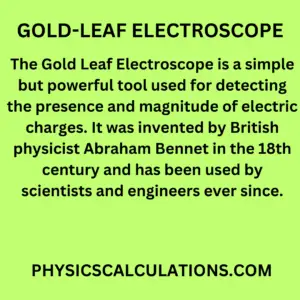What is Gold Leaf Electroscope?
The Gold Leaf Electroscope is a simple but powerful tool used for detecting the presence and magnitude of electric charges. It was invented by British physicist Abraham Bennet in the 18th century and has been used by scientists and engineers ever since. Additionally, the device consists of a glass jar with a metal rod in the center, attached to two thin strips of gold leaf.

When a charged object is brought near the metal rod, the gold leaves move apart due to the repulsion of like charges. In this article, we will explore the Gold Leaf Electroscope in detail, including its components, working principle, and applications in various fields.
Components
The Gold Leaf Electroscope consists of the following components:
- Glass jar. This serves as the container for the electroscope and provides insulation for the components.
- Metal rod. The metal rod, usually made of brass or aluminum, connects the gold leaves through a thin wire and serves as the central component of the electroscope.
- Gold leaves. Thin strips of gold, usually 3-4 cm long, attach to the metal rod and are very thin and lightweight, making them sensitive to the slightest charge.
How does Gold Leaf Electroscope Work?
A Gold Leaf Electroscope is a simple device used to detect and measure electric charges. It consists of a metal rod with two thin gold leaves attached at the bottom. Here is how it works:
- Charging: When an object with an electric charge, such as a negatively charged rod, is brought close to the metal rod of the electroscope, it induces an opposite charge in the leaves due to the principles of electrostatic induction. The negative charge from the rod pushes electrons away in the leaves, leaving them with a positive charge.
- Repulsion: Like charges repel each other, so when the leaves become positively charged, they try to move away from each other.
- Separation: The repulsion between the leaves causes them to spread apart, creating an angle between them. The greater the charge on the metal rod, the more the leaves separate.
- Measuring charge: By observing the angle of separation, you can estimate the amount of charge on the object that initially influenced the electroscope. The larger the angle, the higher the charge.
- Grounding: To discharge the electroscope and bring the leaves back together, you can touch the metal rod with your hand. This process allows any excess charge to flow into or out of the Earth, balancing the electroscope’s charge.
Working Principle of the Gold Leaf Electroscope
This device works on the principle of electrostatic repulsion. Bringing a charged object near the metal rod repels the electrons in the metal rod by the like charge on the object. This will cause them to move to the ends of the gold leaves. Subsequently, this creates a repulsive force between the like charges on the gold leaves. It will now cause them to move apart. Therefore, you can estimate the amount of charge on the object by the amount of separation between the gold leaves.
The Gold Leaf Electroscope works based on the principles of electrostatics. It uses the repulsion between like charges to detect the presence and measure the magnitude of electric charges in objects. When charged, the leaves move apart, and by observing this separation, you can assess the charge’s strength. Touching the rod with your hand can reset the electroscope for further use.
Applications
The Gold Leaf Electroscope has many applications in various fields. Some of the most common applications are:
- Physics. Physicists use it to detect the presence and magnitude of electric charges, as well as to measure the potential difference between two points.
- Chemistry. Chemists use it to detect the presence of ions and other charged particles in their experiments.
- Electrical engineering. Electrical engineers also use it to test the performance of electronic components and circuits.
- Medical research. Medical researchers use it to detect the presence of charged particles in biological samples..
Summary
The Gold Leaf Electroscope is a simple but powerful tool used for detecting the presence and magnitude of electric charges. Its sensitivity and versatility have made it an essential tool in various fields, including physics, chemistry, electrical engineering, and medical research. Therefore, by understanding the components and it’s working principles, scientists and engineers can continue to use this valuable tool to advance their research and experiments.
Frequently Asked Questions (FAQs)
Can we use the Gold Leaf Electroscope to detect both positive and negative charges?
Yes, it can detect both positive and negative charges.
What is the sensitivity of the Gold Leaf Electroscope?
It is very sensitive and can detect charges as small as a few micro coulombs.
How can we charge the Gold Leaf Electroscope?
We can charge it by bringing a charged object near the metal rod. We can also connect the metal rod to a high-voltage source.
You may also like to read:
How to Use a Micrometer Screw Gauge: A Guide for Beginners